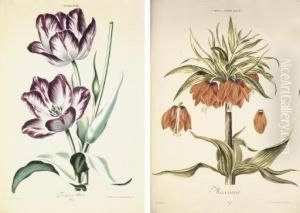Christopher Jakob Trew Paintings
Christopher Jakob Trew (also known as Christoph Jakob Trew) was a prominent German physician, botanist, and an avid patron of natural history during the 18th century. Born on April 26, 1695, in Lauf an der Pegnitz, near Nuremberg, Bavaria, Trew developed an interest in the natural sciences at an early age. His family was well-established, and Trew received a comprehensive education that allowed him to pursue his interests in medicine and the natural world.
Trew's medical studies took him to several universities including Halle, Jena, and Leiden, where he was able to study under some of the leading scientists and physicians of his time. In 1721, he received his doctorate in medicine from the University of Altdorf. After completing his education, Trew established himself as a physician in Nuremberg, where he practiced medicine for the rest of his life. Although he was a respected physician, Trew is best remembered for his contributions to botany and natural history.
Throughout his life, Trew maintained an extensive correspondence with botanists and naturalists across Europe. He was deeply involved in the scientific community and contributed to the advancement of botanical knowledge through his own research and by supporting the work of others. Trew's passion for botany is particularly evident in his collaborative work with the artist and engraver Georg Dionysius Ehret, with whom he produced the magnificent botanical work 'Plantae Selectae' between 1750 and 1773. This publication featured hand-colored engravings of rare plants and was acclaimed for its scientific accuracy and artistic excellence.
In addition to 'Plantae Selectae,' Trew published several other important works on botany and natural history. He was also instrumental in the development of the natural history collection at the University of Altdorf and worked tirelessly to expand the botanical gardens in Nuremberg. Trew's legacy is preserved in the Trew Collection of the Natural History Museum in Nuremberg, which houses an extensive library and herbarium amassed by Trew during his lifetime.
Christopher Jakob Trew died on July 18, 1769, in Nuremberg. His contributions to botany and medicine were significant, and his support of scientific endeavors helped to foster a greater understanding of the natural world during the Age of Enlightenment. Trew's work, particularly his botanical illustrations, continue to be celebrated for their historical importance and beauty.
